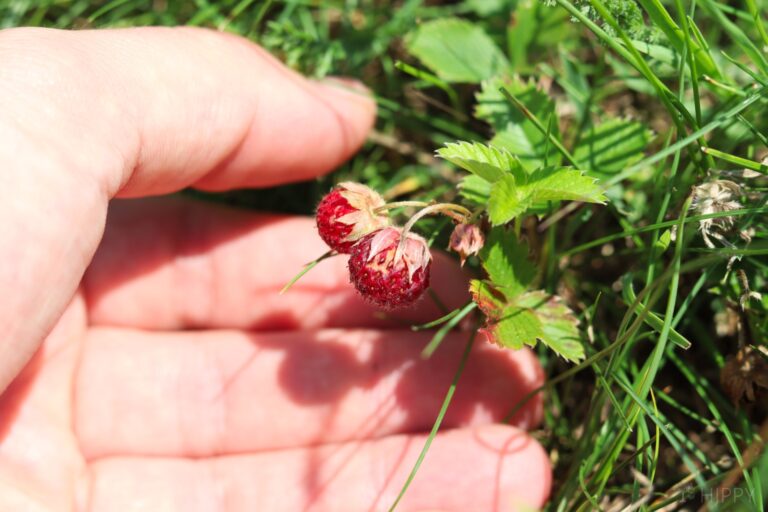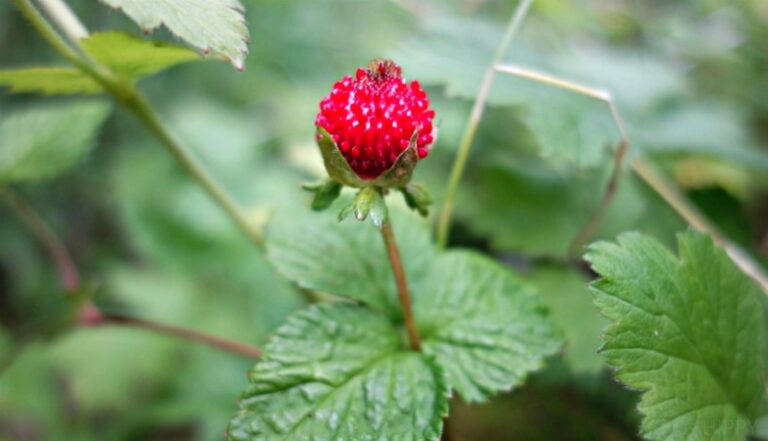Strawberries are a popular fruit commonly used in desserts. The mixed sweet and sour flavor is perfect for a variety of sweet treats including jams, preserves, cakes, pies, strawberries and cream and chocolate fondue.
What about wild strawberries though? Even though they grow all across North America, we’re commonly taught that if you don’t know what it is, don’t touch it. We’re also told not to eat any strange plants that we find in our gardens or elsewhere.

Are wild strawberries edible?
Yes, wild strawberries are, in fact, edible. The true wild strawberry is flavorful and highly nutritious, while the mock strawberry is scentless and flavorless. Neither one will do you any harm – provided, of course, you’re not allergic to them.
Types of Wild Strawberry
There are two types of wild strawberry:
- A true wild strawberry (shown above)
- The mock strawberry
The True Wild Strawberry
Fragaria Vesca also known by the common name wild strawberry, woodland strawberry or alpine strawberry is a member of the rose family and are smaller than their commercial counterparts.
They usually ripen in late spring or early summer. They are full of flavor, and are highly nutritious, making them a great snack or wild-sourced ingredient.
The wild strawberry can be found all over the northern hemisphere, in many environments, so long as they are neither too dry nor too wet.
They are commonly encountered in woodlands, but may also be found growing along trails and roadsides, on hillside or embankments and even among gravel or small rock falls.
Notably, the wild strawberry is more or less tolerant of sun according to its latitude. In the northern reaches of its range it can tolerate more direct sunlight, but will tolerate less sun the further south it is encountered in the northern hemisphere.
This is a surprisingly hardy plant, able to survive being tried upon and even mild fires where it will readily reestablish itself afterward.
The wild strawberry will not always produce fruit when growing in less than ideal conditions, so it pays to be able to identify all parts of the plant, since the leaves and stems are also edible.
The white, five petaled flowers and the tripartite, toothy edged and deeply veined leaves are giveaways.
Also, the easiest way to tell the mock strawberry and true wild strawberry apart (aside from the white flower) is that wild strawberries grow in a drooping fashion, pointing towards the ground or horizontally while immature, whereas mock strawberries typically grow pointing straight up.
Wild Strawberry Nutrition
Wild strawberries are similar to their domesticated cousins when it comes to nutrition, and they contain a small shot of calories and a decent selection of vitamins and minerals.
They certainly make for good eating, and are renowned for their exquisite taste compared to most domestic cultivars.
You can expect a wild strawberry to contain a lot of vitamin C, A small amount of folate and vitamin B6 along with a smattering of the other B vitamins, vitamin E and vitamin K.
Minerals do not fare as well, but you will get plenty of manganese, some magnesium, phosphorus and potassium along with a little bit of calcium and iron along with trace amounts of zinc.
The Mock Strawberry
Another species of wild strawberry is the Indian strawberry or mock strawberry (Potentilla Indica) sometimes called the false strawberry or backyard strawberry.
These are similar to the wild strawberry except that they have yellow flowers / blossoms whereas the true wild strawberry has white or pink flowers.

Mock strawberries also have no scent and no flavor, and only a slightly tinny or metallic aftertaste. This means that they’re edible but not nearly as appetizing and you’ll never see them for sale at your local grocery store.
Like the wild strawberry that it is commonly mistaken for, the mock strawberry can be found growing all over the northern hemisphere and is a frequent fixture in backyards. This is what has led to the nickname of backyard strawberry.
However, unlike the true wild strawberry the mock strawberry grows as a low-lying ground cover plant via runners.
In some areas, it is so successful that it is considered a pest of both residential and wild grasses and it can displace native species in some parts of its range.
Aside from the flowers, which as mentioned above are quite distinctive and yellow in color compared to the wild strawberry, the mock strawberry can also easily be identified by the differences in the shape of its fruit, being far bumpier and texture, and also the fact that it grows facing straight up which makes it easy to identify and spot in the wild.
Mock Strawberry Nutrition
Solid nutritional info on the mock strawberry is difficult to come by, but again the berries are safe to eat, as are the leaves of the plant after gentle cooking.
Though tasteless and hardly appetizing compared to the true wild strawberry, the mock strawberry does contain some vitamins and minerals and a few calories which can help to keep you alive if you are ever in a survival situation.
In any case, they are totally safe to eat so long as you do not suspect them of being contaminated with pesticides or other chemicals.
Something else you might consider is that the mock strawberry, more than the wild strawberry, has been a fixture in traditional medicine around the world for some time…
The whole plant was being used for its antiseptic and anticoagulant properties, and the fruit of the plant itself used as a component in a poultices for skin irritation, burns, abscesses and the like.
If you maintain plants and herbs for use in natural healing, you should definitely consider adding the mock strawberry to your repertoire!
Bottom Line: Can You Eat Wild Strawberries?
So, the final answer is yes, you can definitely eat wild strawberries…
However, the rule of: if you don’t know what it is, don’t touch it will apply until you know that it’s safe to eat/touch. In closing, I hope you guys liked the article, and found it informative.

Greg spent most of his childhood in camping grounds and on hiking trails. While he lives in the suburbs nowadays, Greg was raised on a small farm with chickens. He’s a decent shot with a bow, and a huge knife enthusiast. Find out more about Greg.
